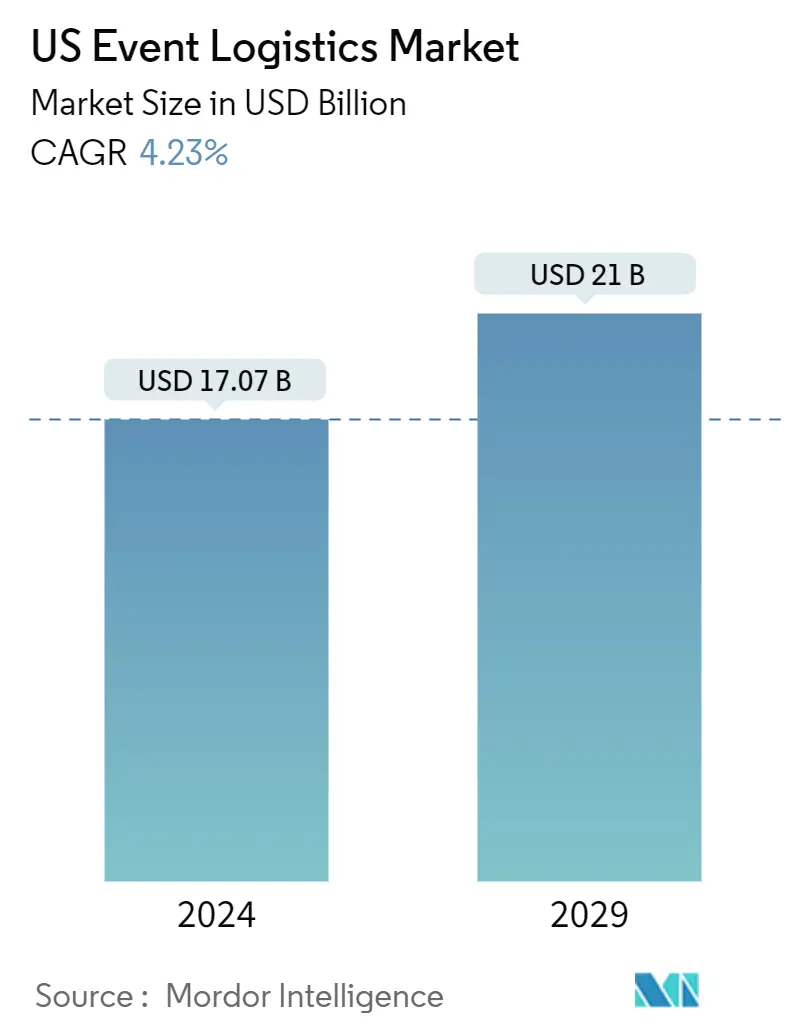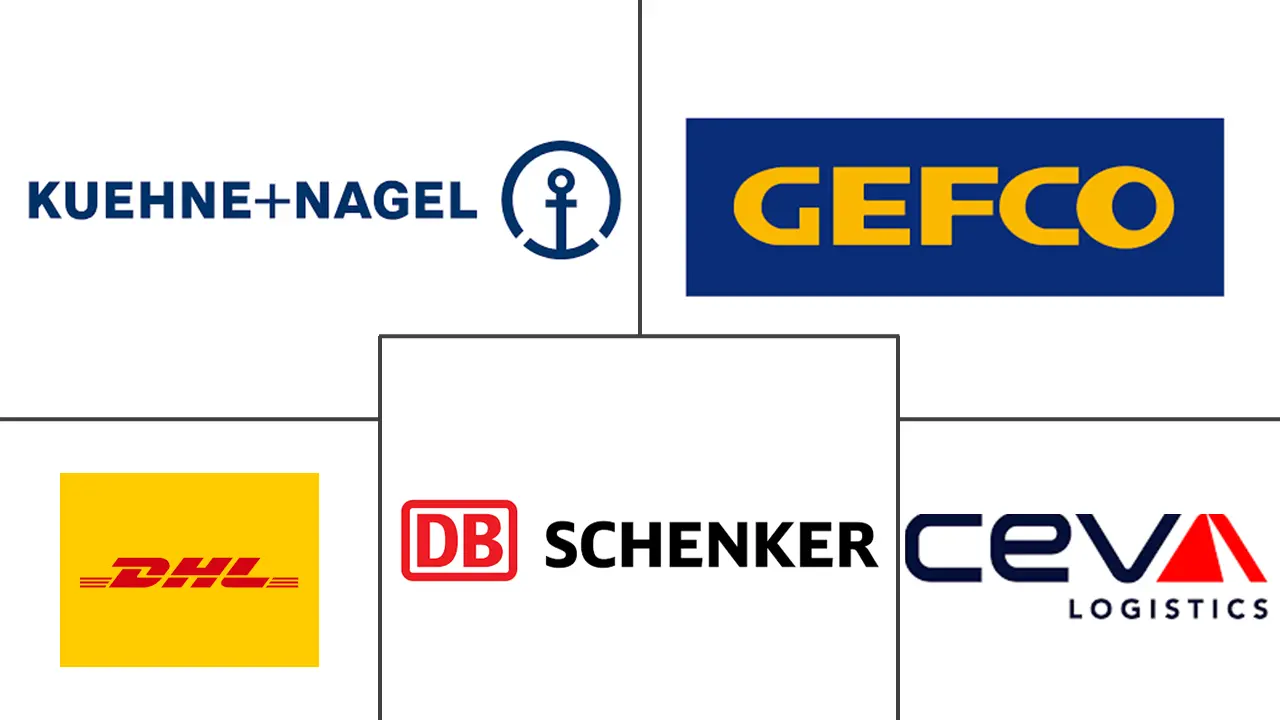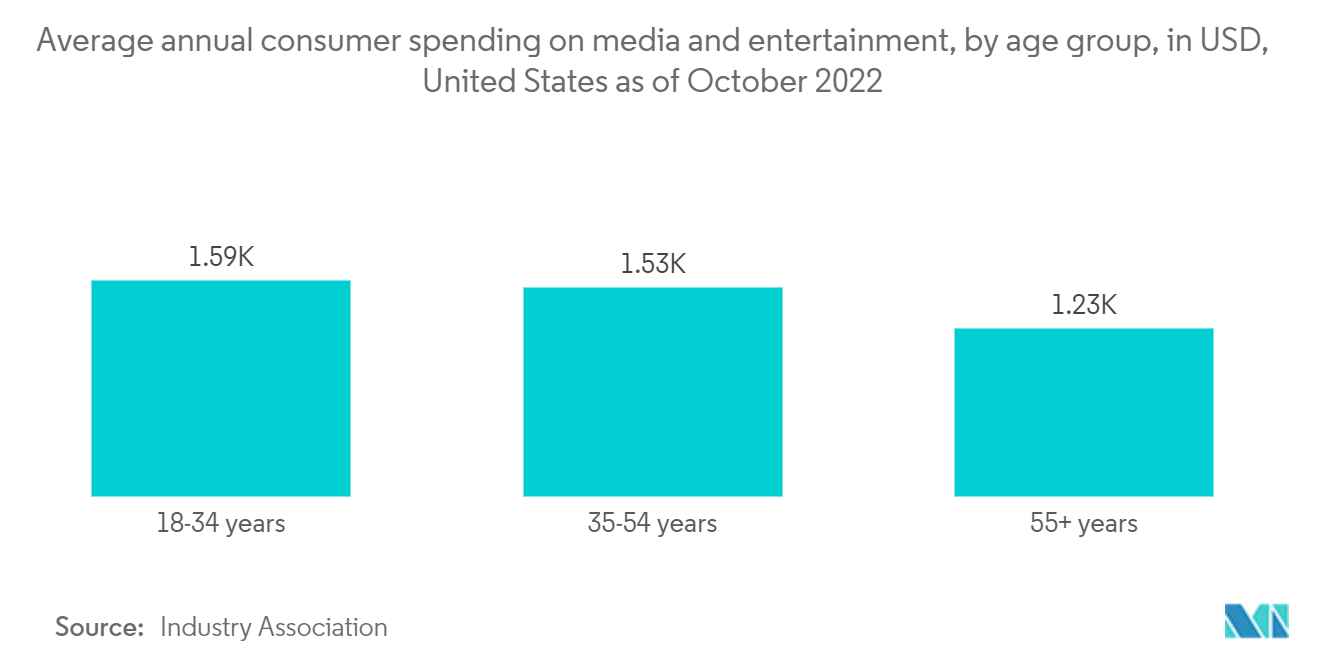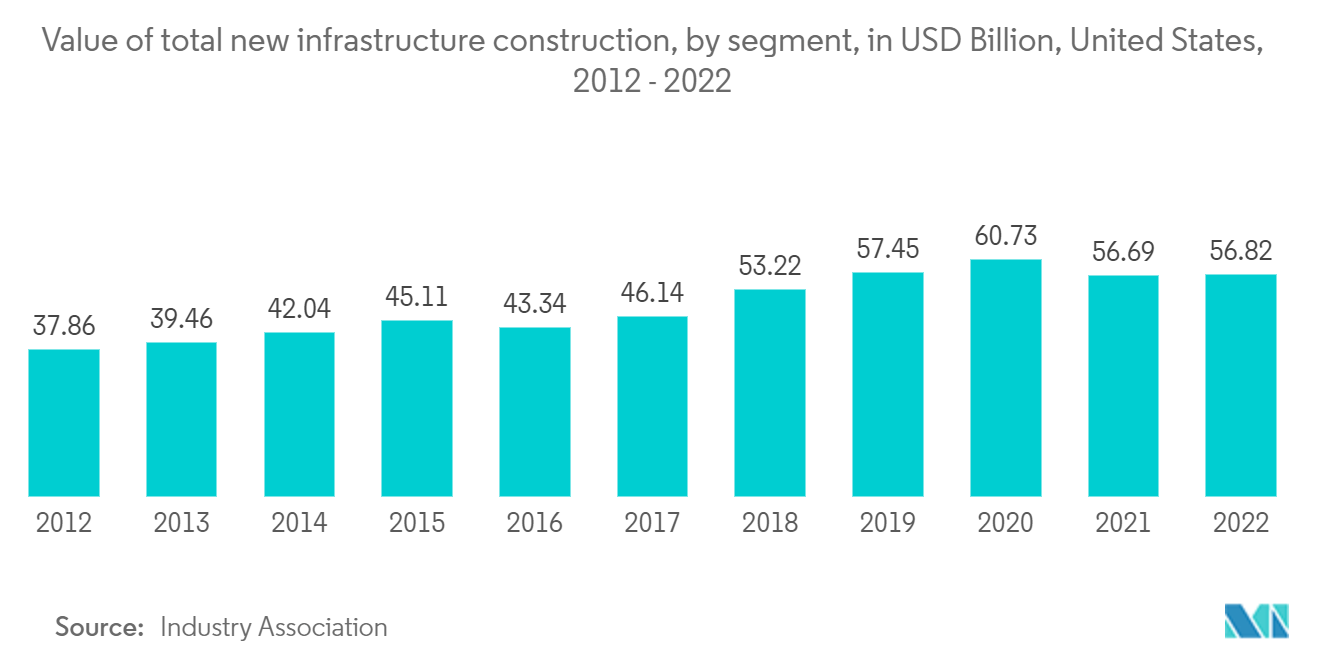US Event Logistics Market Size

| Study Period | 2020-2029 |
| Base Year For Estimation | 2023 |
| Market Size (2024) | USD 17.07 Billion |
| Market Size (2029) | USD 21 Billion |
| CAGR (2024 - 2029) | 4.23 % |
| Market Concentration | High |
Major Players
*Disclaimer: Major Players sorted in no particular order |
US Event Logistics Market Analysis
The US Event Logistics Market size is estimated at USD 17.07 billion in 2024, and is expected to reach USD 21 billion by 2029, growing at a CAGR of 4.23% during the forecast period (2024-2029).
- One of the key factors driving the growth of the US event logistics market is the increasing number and scale of events being held across the country. From large-scale music festivals to corporate conferences, events have become an integral part of business and entertainment culture. This has created a demand for specialized logistics services to handle the unique requirements of each event.
- Event logistics companies play a crucial role in coordinating the movement of equipment, staging materials, merchandise, and personnel to and from event venues. They work closely with event organizers, suppliers, exhibitors, and vendors to ensure that everything is delivered on time and in the right condition. This includes managing transportation, customs clearance, storage, and distribution.
- In recent years, technological advancements have significantly impacted the event logistics market. The use of advanced tracking systems, RFID technology, and real-time data analytics has improved the efficiency and visibility of logistics operations. This enables event organizers to have better control over their supply chain, reduce costs, and enhance the overall event experience.
- Another important aspect of event logistics is sustainability. With growing concerns about environmental impact, event organizers are increasingly focused on implementing eco-friendly practices. This includes optimizing transportation routes, reducing waste generation, and using renewable energy sources. Event logistics companies are playing a vital role in helping organizers achieve their sustainability goals.
- The US event logistics market is highly competitive, with numerous companies offering a wide range of services. These companies differentiate themselves through their expertise, industry partnerships, and ability to handle complex logistics challenges. Some companies specialize in specific types of events, while others offer comprehensive solutions for various event categories.
- In addition to traditional event logistics services, some companies provide value-added services such as event planning, on-site management, and technology integration. They work closely with event organizers to understand their specific needs and provide customized solutions to enhance the overall event experience.
US Event Logistics Market Trends
Increasing demand from media and entertainment segment
- The media and entertainment segment in the United States is a dynamic and vibrant industry that encompasses various forms of entertainment, including television, film, music, gaming, and digital media. It plays a significant role in shaping popular culture and providing entertainment to millions of people.
- One of the key drivers of demand in the media and entertainment segment is the ever-increasing consumer appetite for content. With advancements in technology and the rise of streaming platforms, people now have access to a wide range of content at their fingertips. This has led to a surge in demand for original programming, movies, music, and other forms of entertainment.
- The television industry remains a dominant force in the media and entertainment segment. From traditional broadcast networks to cable channels and streaming services, there is a vast array of content available to viewers. The demand for high-quality scripted shows, reality TV, sports programming, and news continues to grow.
- The film industry also plays a significant role in the media and entertainment segment. Hollywood, located in Los Angeles, California, is known as the entertainment capital of the world. The demand for movies, both in theaters and through digital platforms, remains strong. Blockbuster franchises, independent films, and international productions all contribute to the diverse range of content available to audiences.
- The music industry has undergone significant transformation in recent years. The rise of digital streaming platforms has revolutionized the way people consume music. Streaming services such as Spotify, Apple Music, and Tidal have made music more accessible and convenient. This has led to a surge in demand for music content, with artists and record labels adapting their strategies to reach a global audience.
- Gaming has also become a major player in the media and entertainment segment. With the advent of powerful gaming consoles, mobile gaming, and online multiplayer experiences, the demand for video games has skyrocketed. Gamers of all ages and backgrounds are constantly seeking new and immersive gaming experiences, driving the demand for innovative and engaging content.
- Digital media has emerged as a key component of the media and entertainment segment. Social media platforms, video-sharing sites, and online content creators have gained immense popularity. The demand for viral videos, influencer content, and user-generated content continues to grow, with advertisers and brands recognizing the value of digital platforms in reaching their target audiences.

Increasing transportation infrastructure driving the market
- Transportation infrastructure in the US is a vast and complex system that includes roads, bridges, railways, airports, and ports. It plays a crucial role in connecting people, goods, and services across the country.
- One of the key components of transportation infrastructure is the road network. The United States has an extensive road network that spans millions of miles, connecting cities, towns, and rural areas. Highways, interstates, and local roads are essential for commuting, transporting goods, and facilitating economic growth. The demand for well-maintained roads and highways is always high to ensure safe and efficient travel.
- Bridges are another critical part of transportation infrastructure. They provide vital connections across bodies of water, canyons, and other obstacles. The United States has numerous iconic bridges, like the Golden Gate Bridge in San Francisco and the Brooklyn Bridge in New York City. Maintaining and upgrading bridges is crucial to ensure their safety and longevity.
- Railways have played a significant role in the development of transportation infrastructure in the United States. Freight railroads transport goods across the country, supporting industries and supply chains. Passenger rail services, such as Amtrak, provide an alternative mode of transportation for travelers. The demand for efficient and reliable rail services continues to grow, with efforts to improve and expand rail networks.
- Airports are essential for domestic and international travel. The United States has a vast network of airports, ranging from small regional airports to major international hubs like Hartsfield-Jackson Atlanta International Airport and Los Angeles International Airport. Airports facilitate tourism, business travel, and cargo transportation, contributing to economic growth. The demand for modern, well-equipped airports with efficient operations is crucial to meet the needs of travelers.
- Ports are crucial for maritime transportation and international trade. The United States has major seaports on the East Coast, West Coast, and Gulf Coast, including the Port of Los Angeles, the Port of Long Beach, and the Port of New York and New Jersey. These ports handle a significant volume of imports and exports, supporting economic activities and global supply chains. The demand for efficient port operations, infrastructure upgrades, and intermodal connections is vital for international trade.

US Event Logistics Industry Overview
The US event logistics market is quite competitive, with several players vying for a piece of the pie. In the United States, there are numerous companies that specialize in event logistics and offer a range of services to support the planning and execution of events. These companies provide services such as transportation, warehousing, venue setup, equipment rental, and more.
The competitive landscape is constantly evolving, with new players entering the market and existing ones expanding their services. The key to success in this industry lies in delivering high-quality services, building strong relationships with clients, and staying ahead of the curve with innovative solutions.
US Event Logistics Market Leaders
-
Kuehne + Nagel International AG
-
Gefco
-
Ceva logistics
-
DB Schenker
-
DHL International GmbH
*Disclaimer: Major Players sorted in no particular order

US Event Logistics Market News
- September 2023: SGS completed acquisition of global supply chain and operations consulting firm Maine Pointe.
- February 2023: XPDEL, one of India’s leading hi-tech 3PL logistics companies, announced major expansion plans for India. XPDEL currently has three fulfillment centers located in Delhi, Mumbai and Bangalore. XPDEL plans to further expand its position as a 3PL company in India by opening a 4th fulfillment center in Delhi this quarter. This new building will be equipped with cutting-edge technology solutions to deliver an unmatched customer experience.
US Event Logistics Market Report - Table of Contents
1. INTRODUCTION
- 1.1 Study Assumptions and Market Definition
- 1.2 Scope of the Study
2. RESEARCH METHODOLOGY
3. EXECUTIVE SUMMARY
4. MARKET INSIGHTS
- 4.1 Current Market Scenario
- 4.2 Industry Value Chain/Supply Chain Analysis
- 4.3 Impact of COVID-19 on the Market
5. MARKET DYNAMICS
-
5.1 Market Drivers
- 5.1.1 Growing Events in E-commerce Sector
- 5.1.2 Increasing Demand for Qualified Event Logistics Services
-
5.2 Market Restraints/Challenges
- 5.2.1 High Labour Cost
- 5.2.2 High Pricing
-
5.3 Market Opportunities
- 5.3.1 Technological Advancement in Event Logistics
- 5.3.2 Sustainability Initiatives
-
5.4 Industry Attractiveness - Porter's Five Forces Analysis
- 5.4.1 Bargaining Power of Suppliers
- 5.4.2 Bargaining Power of Buyers/Consumers
- 5.4.3 Threat of New Entrants
- 5.4.4 Threat of Substitute Products
- 5.4.5 Intensity of Competitive Rivalry
6. MARKET SEGMENTATION
-
6.1 By Type
- 6.1.1 Inventory Control
- 6.1.2 Distribution Systems
- 6.1.3 Logistics Solutions
-
6.2 By Application
- 6.2.1 Entertainment
- 6.2.2 Sports
- 6.2.3 Trade fair
- 6.2.4 Other Applications
-
6.3 By Geography
- 6.3.1 Germany
- 6.3.2 UK
- 6.3.3 Spain
- 6.3.4 Italy
- 6.3.5 France
- 6.3.6 Rest of Europe
7. COMPETITIVE LANDSCAPE
- 7.1 Overview (Market Concentration and Major Players)
-
7.2 Company Profiles
- 7.2.1 Kuehne + Nagel International AG
- 7.2.2 Gefco
- 7.2.3 Ceva logistics
- 7.2.4 DB Schenker
- 7.2.5 DHL International GmbH
- 7.2.6 FedEx Corporation
- 7.2.7 Rhenus SE & Co. KG
- 7.2.8 United Parcel Service of America, Inc.
- 7.2.9 XPO Logistics, Inc.
- 7.2.10 Geodis
- 7.2.11 *List Not Exhaustive
- *List Not Exhaustive
8. FUTURE OF THE MARKET
9. APPENDIX
** Subject To AvailablityUS Event Logistics Industry Segmentation
The US event logistics market refers to the planning, coordination, and execution of logistics operations for various types of events, such as conferences, trade shows, concerts, and sporting events. It involves managing the transportation, warehousing, inventory, and other logistical aspects to ensure the smooth flow of goods, equipment, and personnel.
The US event logistics market is segmented By type, by end-user, by region. By type, the market is segmented into inventory management, delivery systems, and freight forwarding. By end-users, the market is segmented into entertainment and media, sports, corporate events and trade fairs, and other end-users. By region, the market is segmented into the United Kingdom, Germany, Spain, France, Italy, Russia, and the Rest of Europe.
The report offers market size and forecast value in USD for all the above segments.
| By Type | Inventory Control |
| Distribution Systems | |
| Logistics Solutions | |
| By Application | Entertainment |
| Sports | |
| Trade fair | |
| Other Applications | |
| By Geography | Germany |
| UK | |
| Spain | |
| Italy | |
| France | |
| Rest of Europe |
US Event Logistics Market Research FAQs
How big is the US Event Logistics Market?
The US Event Logistics Market size is expected to reach USD 17.07 billion in 2024 and grow at a CAGR of 4.23% to reach USD 21 billion by 2029.
What is the current US Event Logistics Market size?
In 2024, the US Event Logistics Market size is expected to reach USD 17.07 billion.
Who are the key players in US Event Logistics Market?
Kuehne + Nagel International AG, Gefco, Ceva logistics, DB Schenker and DHL International GmbH are the major companies operating in the US Event Logistics Market.
What years does this US Event Logistics Market cover, and what was the market size in 2023?
In 2023, the US Event Logistics Market size was estimated at USD 16.35 billion. The report covers the US Event Logistics Market historical market size for years: 2020, 2021, 2022 and 2023. The report also forecasts the US Event Logistics Market size for years: 2024, 2025, 2026, 2027, 2028 and 2029.
US Event Logistics Industry Report
Statistics for the 2024 US Event Logistics market share, size and revenue growth rate, created by Mordor Intelligence™ Industry Reports. US Event Logistics analysis includes a market forecast outlook to for 2024 to 2029 and historical overview. Get a sample of this industry analysis as a free report PDF download.



